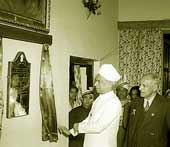|
|
| Sarvepalli Radhakrishnan unveiling the BCCI?s silver jubilee plaque at the Roshanara Club Pavilion in 1954 |
The Board of Control for Cricket in India has invited Pakistan to commemorate its platinum jubilee celebrations. This is a most appropriate gesture made to a fantastic cricketing nation. But the grand gesture was long overdue. In 1951, when Pakistan made its debut in official test cricket, it did not rush towards England, as is the general trend, but opted for its next door neighbour, India.
In 1954, when the BCCI celebrated its silver jubilee, an invitation was not extended to Pakistan but to a team of cricketers from the English county cricket championships. The combination was named Silver Jubilee Overseas Cricket Team, and five unofficial tests were arranged at various centres around the country. Later, for the golden jubilee of the BCCI, the England test side came to play a one-off test match at Mumbai.
Today, in keeping with the times, no longer is it a series of tests nor a one-off test match, but a one-day international. Further, as if to highlight the shift in the sphere of influence in Indian cricket, the venue is not Mumbai but Jagmohan Dalmiya?s Calcutta. To rub more salt into the wound, the favoured team is no longer England, but the popular and brilliant cricketers from Pakistan.
The BCCI has come a long way from the Twenties. When Arthur Gilligan?s men came to India in the winter of 1926, the BCCI had not yet come into existence. In fact, there was no controlling authority for cricket. The game in India was in a disorganized state, with provincial centres hosting inter-community tournaments. It required the enterprise of the Calcutta Cricket Club, with financial assurance from Bengal Gymkhana, to prevail upon the powers-that-be at Lord?s to send a team to India. The MCC chose Arthur Gilligan, a man of wisdom, to see for himself what India had to offer by way of cricket.
Gilligan was quick to grasp that the Indians were ?naturals? at cricket. He was impressed by the tour logistics and arrangements, the on-field facilities, the enthusiasm of the crowds, and most of all, by the high standard of cricket played by the local Indian cricketers. He marvelled at the temperament and technique of Deodhar and the adventurous strokeplay of C.K. Nayudu. On reaching England, Gilligan lost no time to highly recommend India for official test match status.
But there was one big hurdle. Indian cricket was yet to have a controlling authority. The International Cricket Council (then the Imperial Cricket Conference) assured that the moment India established a cricket controlling body, the permission for official test match status would be just a formality.
And so it was. The board came into being, with the princely patrons playing a very significant role. The inaugural tour of England took place in 1932 with India?s first-ever test match at Lord?s. Ironically, the man who made the most important contribution to India?s entry into international cricket ? Professor Deodhar of Pune ? was not in the touring team!
The captain selected for the tour was the Maharaja of Porbandar, Rana Saheb, and his deputy was Ghanshyamji, the Maharaja of Limbdi. To the credit of both, they refrained from playing in the test match. Thus the honour of leading India in the inaugural test went to the highly deserving C.K. Nayudu.
Since then, the BCCI has undertaken massive and vital projects. Mumbai became the headquarters and the Maharaja of Patiala donated the Ranji Trophy, the symbol of competitiveness among the states. Coaches from England and Australia started arriving at the behest of the maharajas, particularly those of Patiala and Cooch Behar. Organized school cricket at the all- India level began early so that talent could be identified and nurtured. Regular exchanges of tours began, and the number of domestic tournaments increased.
The BCCI administrators, unlike their counterparts in other disciplines in India, were generally conscientious and honest, hard-working and accessible. The Delhi-based Anthony D?Mello set the ball rolling. Later, Pankaj Gupta, the Maharaja of Gaekwad, M.A. Chidambaram, R. Sriman, Chinnaswami, the Maharaja of Gwalior, Raj Singh Dungarpur and Biswanath Dutta among others played vital roles to keep the Indian cricket caravan on the road.
With the arrival of Jagmohan Dalmiya, the whole concept of cricket administration in the country almost changed overnight. He had neither the time nor the inclination to be a back-bencher. He forged ahead in style and splendour, and forced the ICC to crown him its chairman. Dalmiya made the sponsors dance to his tune, kept the players happy and tackled the media with rare skill. The BCCI coffers were more than full, and so was the bank-balance of the ICC.
Cricket suddenly became big business. No longer was cricket merely a winter sport, but a thriving, round- the-year commercial activity. As it is usual in India, the organizations governing other sports are seething in jealousy and speculators are trying to get onto the cricket bandwagon. Herein lies the danger. Let the 75th anniversary of the BCCI not be the beginning of a slide-down.


